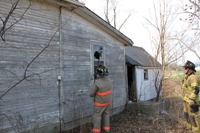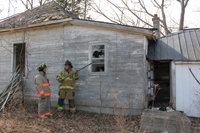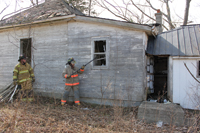
Features
Structural
Training
Back to Basics: February 2011
Ventilation is a major component of truck company operations. Ventilation is the systematic removal of heat, smoke and unburned gases and the replacement of bad air with clean air. Ventilation allows crews to suppress the fire more quickly, and, to a certain degree, ventilation removes the intensity from the fire.
February 8, 2011
By Mark van der Feyst
Ventilation is a major component of truck company operations. Ventilation is the systematic removal of heat, smoke and unburned gases and the replacement of bad air with clean air. Ventilation allows crews to suppress the fire more quickly, and, to a certain degree, ventilation removes the intensity from the fire.
Ventilation can be accomplished in a number of ways, and depending on the situation, a team of firefighters can use one or more ventilation options. Each method has benefits and drawbacks but each can be effective for the application for which it is chosen.
 |
|||
| Photo 1. Removing the windows is a quick way to ventilate the structure. This method of ventilation allows the firefighter to stay outside the building and is a good way to maintain accountability. |
|||
 |
|||
| Photo 2. The firefighter avoids exposure to any smoke, hot gas or fire by turning his back to the building while swinging the roof hook to break the window. | |||
 |
|||
| Photo 3. It is vital to remove everything from the window, including any sashes, screens or debris. The window can act as a secondary means of egress, and any obstruction may hinder the rescue. Photos by Mark van der Feyst |
One method for quickly ventilating a structure is to remove the windows. This is known as horizontal ventilation. This task can be accomplished by one firefighter on the outside of the structure. Armed with certain tools, this firefighter can be very effective in the removal of hot gases, smoke and heat. Because the firefighter is on the outside of the structure, accountability can be maintained with the incident commander or the incident safety officer.
Before any windows are removed or broken, a few important factors must be considered and a quick size-up must be performed. The size-up includes life safety, fire and smoke conditions, the structure and adjoining buildings, and the other operations that may be taking place.
■ Life safety
- Determine where the occupants are inside the structure? Are they located between the fire and the opening?
- Identify escape routes for rescues.
- Determine the effects of ventilation on the victims inside: Will it increase or decrease their chances of survival?
- Are you venting for life?
■ Fire and smoke conditions
Are backdraft or flashover conditions present?
Will the opening lend to the development of the fire?
Are you venting for fire?
■ The fire building and adjoining buildings
- How close are the exposures?
- Will venting create auto exposure?
- What size are the windows? They need to be a good size to allow for proper removal of smoke and hot gases and the introduction of clean air.
■ Other operations
- Are search operations being conducted?
- Is the hoseline in place, ready for fire suppression?
- Will the vent opening draw the heat and smoke toward attacking crews or away from them?
- Is this a co-ordinated effort?
Knowing where the fire is located will help in selecting the window(s) to be removed. Arbitrarily breaking windows for the sake of ventilation will not work; this can (and will) lead to disastrous consequences. This information can be communicated from the interior search crews, the interior fire attack crews or the incident commander to the outside ventilation crew.
The firefighter assigned to take out the windows must be equipped with the proper tools. The location of the window dictates the type of tools needed. If a second-floor window needs to be broken, then a ground ladder or a long pike pole is required. For second-floor applications, it is safer to use a ground ladder in conjunction with a smaller hand tool than to use a long pike pole. With a long pike pole, there is a higher risk of falling glass coming down on the firefighter, although using a ground ladder takes longer than using a long pike pole.
Good tools to use for window ventilation are the pike pole (six to eight feet), the roof hook (five or six feet), an axe or a haligan. Pike poles and roof hooks allow you to reach the target without getting too close. A pike pole that’s too long prevents you from having full control of the tool; a shorter pike pole or roof hook gives you full control over the operation.
In photo 1, a firefighter is assigned to take out the ground floor window. He is equipped with a five-foot roof hook and safety glasses. As this was a training exercise, an SCBA was not worn. The firefighter in the photo is positioned to break the window with a forward chopping motion. His body is facing the window as he uses his arms to complete the movement. He is still off to one side of the window, allowing him to be protected from any expulsion of hot gases, smoke or even fire. You will also notice that he has started up high on the window and is working his way down to the bottom. This ensures that the falling glass does not become a hazard for the firefighter.
In photo 2, instructor Tim Llewellyn demonstrates another way for firefighters to position themselves to break the window without fatiguing quickly. Notice how his back is to the building; this protects him from any expulsion of smoke, hot gas or fire. Instead of using a forward chopping motion to break the window, he uses a rotational motion to swing the roof hook, keeping his arms static. Swinging the roof hook with all of his body allows him to exert more force to break the window, without tiring too quickly. Depending on the type of window, a good amount of force may be necessary to complete the task. This position forces the firefighter to stay to the side of the window, as opposed to the previous position, which allows a person to slowly creep in front of the window.
In photo 3, all the glass has been broken and removed from the window but the task is not complete until the entire window is open and clear. Y The window needs to be removed, sash and all (including the screen) to be an effective, ventilated opening and a secondary exit for firefighters. A screen on a window decreases the amount of smoke and hot gas that can exit the room. When everything is removed from the window, rake your roof hook along the sides of the window frame to ensure no sharp jagged pieces of glass are present.
Removing a window for ventilation may seem simple but firefighters need to keep in mind all the considerations mentioned above. Seize opportunities to break windows during practice sessions and work on these different positions to determine which one works best for you.
Mark van der Feyst is a 12-year veteran of the fire service. He currently works for the City of Woodstock Fire Department.
Print this page